Overview: What are gas hydrates?
Gas hydrate and methane hydrate
The term “methane hydrate” is often used in Japan, in particular on news release, TV program and outreach activities, in stead of “gas hydrates.” This is because that gas hydrate exploration project in the eastern Nankai Trough is named methane hydrate project and referred as MH21 project. However, marine hydrate is not always methane hydrate but may contain significant amount of ethane, and the term “gas hydrate” is scientifically better than “methane hydrate” . Therefore we used gas hydrate as the name of the laboratory, but may use “methane hydrate” in Japanese report and outreach activities to avoid misunderstanding and confusion.
What are gas hydrates?
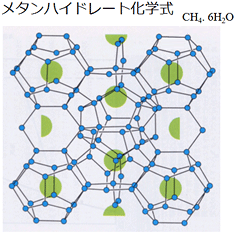
Gas hydrate is an ice-like solid material composed of water and methane molecules. 1 m3 of gas hydrate contains 160 m3 of methane (at 25 ℃ and 1 atm). Gas hydrate is stable under low temperature and high pressure condition.
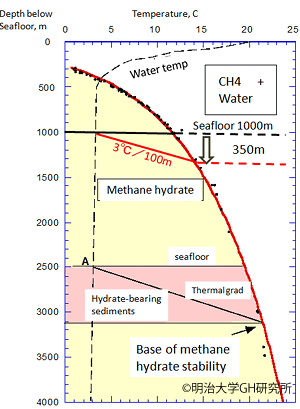
modified from Kvenvolden (1988)
World distribution of gas hydrates
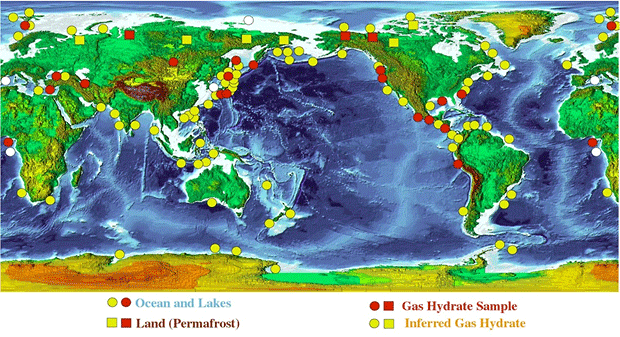
Red: confirmed by coring, Yellow: inferred from BSR distribution
(after M. Sato of AIST, unpublished)
Two types of marine gas hydrates
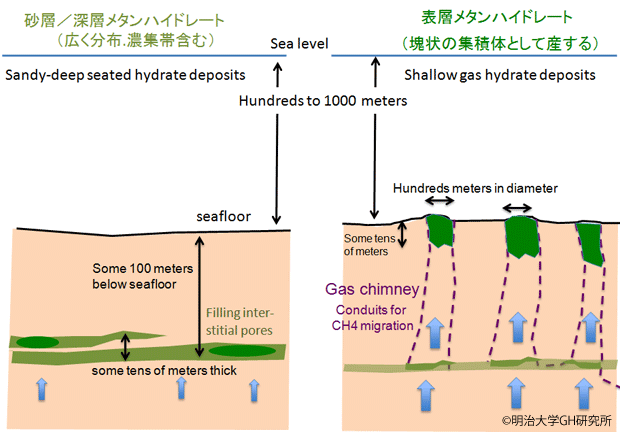
Type 1 gas hydrates occur in Nanakai Trough, where MH21 methane hydrate project has been exploiting pore-filling type hydrate in sandy horizon. Type 2 gas hydrates occur as massive nodular aggregates in Japan Sea, concentrated within hydrate mound and gas chimneys.
Discovery of methane hydrate from Japan Sea
Distribution of pore-filling, sandy type gas hydrate deposits is easily referred from the acoustic anomaly horizon (=BSR) corresponding to the base of gas hydrate stability (Fig.2). Owing to a great exploration effort of Yutaka Aoki, JAPEX, wide distribution of BSRs has been delineated Nankeen trough in 1980’s. Sandy type hydrates have been believed to develop right above the BSRs. Actually in 1990, DSDP Leg 131 expedition recovered hydrate samples from Nankeen trough offshore Shikoku. However, no direct evidence was reported from Japan’s EEZ of Japan Sea to indicate the existence of gas hydrate in 1990’s, except for a recovery of small chunks of gas hydrates from offshore Okushiri island, western Hokkaido during DSDP Leg 127 in 1989. Due to detailed study and analysis of existing profiles, BSRs have been identified also in Japan Sea (Fig. 5).
In 2003, geotechnical study and site surveys for “Deep Stratigraphic Drilling” for conventional oil and gas offshore SW Sado Island recovered gas hydrate sample from a few meters below seafloor unprecedentedly. This is actually the first discovery of shallow gas hydrate from Japan Sea. However this finding had not been disclosed to the public until Monzawa et al. in 2006. R. Matsumoto (presently the leader of MU Gas Hydrate Research Laboratory) and his research team of Tokyo University have commenced an integrated geological and geophysical survey of potentially gas hydrate field in Joetsu basin (= SW Sado island) in 2004. They recovered a lots of gas hydrate samples from these area and revealed that gas hydrate tends to concentrate on hydrate mounds which are underlain by deep gas chimney structures. Their first and concrete findings have been presented at ICGH-5 (The 5th International Conference on Gas Hydrates) at Trondheim, and shared with the international hydrate science community. University research team, now based at Maiji University, has revealed that the similar gas chimney structures are widely distributed in Oki trough to the west and Mogami trough to the north of Joetsu basin.
Gas hydrate bearing sediments exhibit characteristic acoustic features. Sandy type, deep-seated hydrate deposits are often associated with anomalously strong reflectors, BSRs, while shallow gas hydrates are characterized by vertical stack of acoustic chaotic zone, called gas chimney. Acoustic anomalies are strong indication of the occurrence of gas hydrate, but the actual existence of hydrates is confirmed only by the recovery of samples.
From the Academic Research to Resource Exploration
Among a number of criteria to evaluate the resource potential of shallow gas hydrates, “the amount of the hydrate source” is primarily important criteria. They may not become a resource if the resource amount is not large enough. Therefore, the first step to evaluate the resource potential is the assessment of the resource amount. As has been revealed by academic research, shallow gas hydrate occurs in and above gas chimney structure. Total amount of gas hydrate is roughly estimated by the number of gas chimneys and approximate amount of hydrate within a single gas chimney. Drilling and coring down to the center of gas chimneys should provide critical parameter to obtain the amount of gas hydrate stored in gas chimney structures.
BSR and marine gas hydrates.
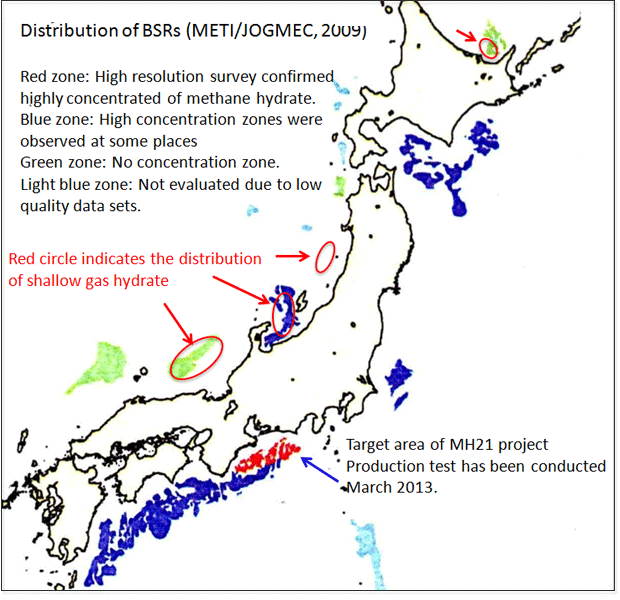
Distribution of BSR (Bottom Simulating Reflector) around Japan islands, indicating the distribution of deep-type (sand-type) hydrate. Red color zone in the Pacific Ocean shows the survey and exploration zone of MH21 projecte, while red circles in Japan Sea and Okhotsk Sea are the distribution of shallow gas hydrate, which occur within gas chimneys and hydrate mounds.
Gas chimney structures and gas hydrate exposure on the cliff of hydrate mounds
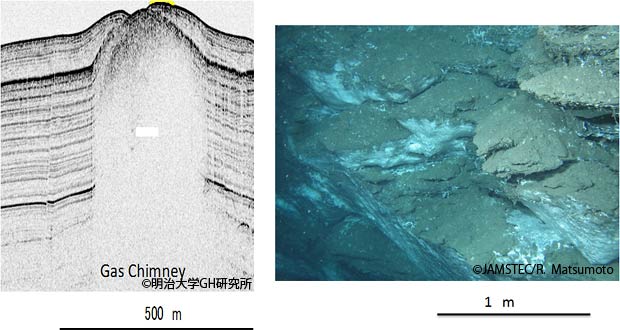
Gas chimney structures identified by SBP survey of AUV and gas hydrate exposure on the cliff of hydrate mounds.
Massive hydrate extrudes from partly collapsed hydrate mound
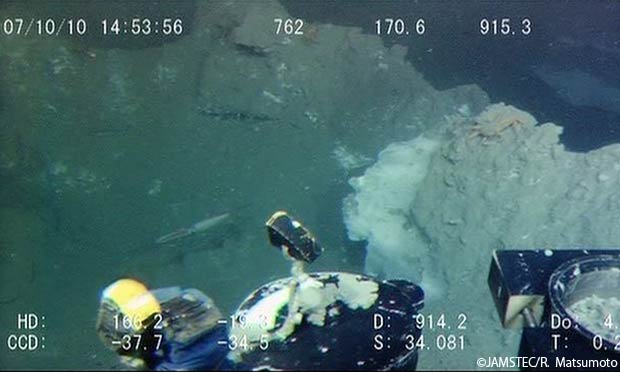
Massive hydrate, 50 x 50 x 30 cm, extrudes from partly collapsed hydrate mound. Umitaka spur, Joetsu basin, Japan Sea.
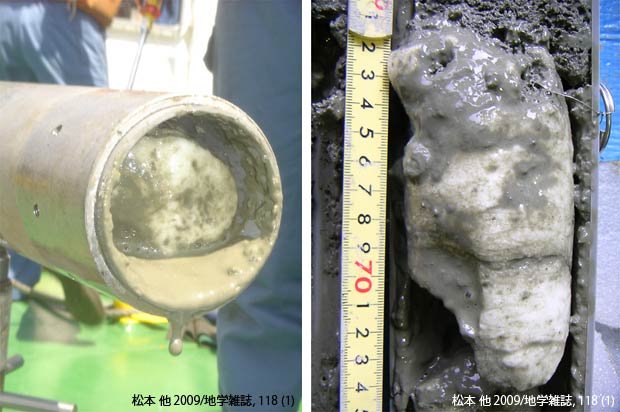
Recovery of massive methane hydrate sample by piston core. Massive methane hydrate usually occur at the bottom of the cores. This is probably because that massive accumulation of methane hydrate in shallow sediments blocked the penetration of piston core.